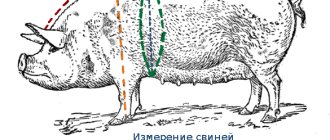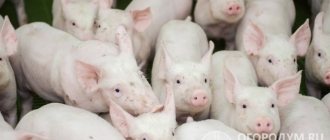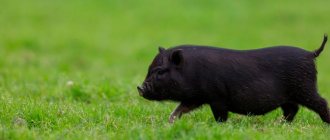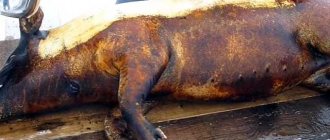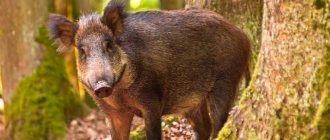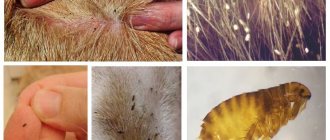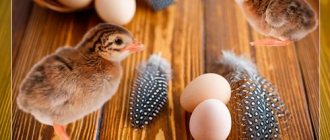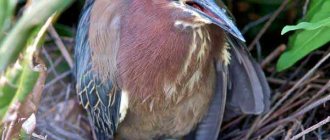Proper mating and farrowing of Vietnamese pigs are the key to successful breeding of these animals. The strong immunity of pot-bellied piglets is developed at an early age, so the birth process must take place in full compliance with veterinary standards. For mating, you need to use proven breeding boars, and for farrowing, you need to provide the sow with the most comfortable conditions.
Early maturing pigs with a calm character
Pot-bellied piglets are characterized by early puberty and already at the age of 3.5-4 months the future sow is ready to reproduce. However, a young pig at this age continues to develop into an adult animal. Therefore, experienced livestock breeders do not recommend covering a Vietnamese pig until it reaches a weight of 30-35 kg.
It is possible to determine that a female has entered the hunting period by external signs. She loses her appetite, becomes restless, the genital loop area swells and periodic mucus is noticeable.
If you lightly press on the back of a pig in heat, it stops moving and freezes in place, demonstrating its readiness to copulate. If such signs appear, you should not delay it and you need to let the breeding boar approach it.
Readiness to mate and pregnancy
Vietnamese pigs experience early puberty. They are ready to reproduce after four months, and this with a weight of 35 kilograms. As soon as the time comes, individuals of different sexes are left alone in the room. After two days, the animals are returned to the general pen.
To understand whether a sow is pregnant or not, you need to take a closer look at her behavior. She behaves calmly, sexual searches stop. The main signs of pregnancy appear. The first is active weight gain. Literally before our eyes, the animal begins to enlarge after pregnancy, its muscles grow. By the end of the term, pigs look like an elongated ball.
With the onset of an interesting situation, the pig requires good feeding, which will allow it to bear cubs. She needs more than one kilogram of food per day. After farrowing, pigs lose weight dramatically, so they must gain a lot of weight during pregnancy.
There are no big changes in the appearance of pot-bellied pigs. A general increase in body weight is noticeable. The animal eats well, is calm, and does not move actively. Towards the end of the term, you can only notice an increase in the abdomen and nipples, and the back part expands. The pig must remain in comfortable home conditions throughout the entire period. She needs a warm and clean room, especially in winter. It is advisable to avoid clashes with other pigs.
Use multiple manufacturers
Mating of Vietnamese pigs is quite easy. To do this, you need to lock the female and the male in a separate pen and give them the opportunity to spend 1-2 days together. This time will be quite enough to cover. No assistance from the livestock breeder is required in this process.
For many years, experts involved in pig breeding claim that pregnancy is easier, and stronger offspring are born, if the females are successively covered by several wild boars, the number of which should not exceed three.
To exclude the possibility of obtaining non-viable offspring, it is necessary to use boars that are not related to the female for mating.
If pregnancy does not occur, then after 22 days the female will begin the hunting period again. In this case, it is necessary to cover it with a boar that did not take part in the previous mating.
What to feed Vietnamese pigs?
There are many conflicting rumors about feeding Vietnamese pigs. Some novice pig farmers believe that these animals are omnivores and there is no fundamental difference between different types of feed for them. To some extent this is true, but for rapid growth and weight gain it is necessary to adhere to strict feeding rules.
Video - experience in breeding Vietnamese pigs
Vietnamese pigs are a bacon breed, so their diet should be dominated by foods that help store fat. These pigs are distinguished by a unique digestive system (small stomach and short intestines), which ensures the rapid passage of food through the esophagus.
Hard feed containing dense fiber is poorly absorbed by the body of Vietnamese pigs. Legumes and greens are considered the best feed option for these animals. It is better not to give food in liquid form to pigs, since they will immediately swallow such food without chewing it in their mouth. Thick porridge, as well as fruits and vegetables, work well. It is allowed to feed pigs with food waste - potato peelings, apple cores, banana peels and other food scraps from the table. The more varied the diet, the better.
Little piglets should be fed mother's milk for up to 1-1.5 months, but it is advisable to introduce complementary foods from the second week after birth. At one month of age, you can take them away from their mother and place them in a separate pen. The diet of piglets up to 1 month should contain porridge with milk (barley, wheat, corn or oatmeal); from the age of one month, fresh hay can be given. For small pigs, herbs such as nettle, clover, sainfoin, quinoa, and acorn are best suited.
Adult pigs need to be fed according to the season. In the summer, it is enough to feed twice a day, and it is recommended to feed more greens and vegetables. In the winter months, tops and hay are suitable, and feed should be given 3 times a day. If mixed feed is used, it must be mixed with bran - in this form it will be absorbed much better.
Vietnamese pigs should not be fed any grain. For example, it is better not to feed them corn and oats, since these products will provoke the accumulation of fat and will be bad for the health of the pigs. In addition, excess fat deposits will negatively affect the quality of meat. Recommended grains for adults are barley, rye and wheat.
Table - standard requirements for pigs in basic nutrients
Pregnant sows can be fed the same food as regular pigs, but it is recommended to enrich the feed with vitamins - for example, add 1 raw egg, 2 tablespoons of fish oil or whey per 10 kg of feed. If you plan to slaughter a pig, you should switch to a special diet a month before slaughter. The following daily diet promotes maximum weight gain: (50%), oats (10%), wheat (20%), corn (10%) and peas (10%).
Know how to use a farrowing chart
Due to the fact that Vietnamese pot-bellied pigs are capable of producing offspring twice a year, the owner of a small farm needs to adjust his plans by purchasing the required amount of feed right before the farrowing period.
In order to find out the approximate farrowing time of a sow, experts have compiled the table below.
It is very easy to use. You just need to combine the mating date with the month of the year and you can find out the approximate farrowing date of your pig. This will provide an opportunity to prepare for childbirth and conduct it at the highest level.
Farrowing chart:
Farrow date calculator
The pot-bellied Vietnamese pig is classified as a bacon-type breed; it is raised for both lard and meat, with the meaty part of the carcass accounting for up to 80% of the total weight of the pig. It turns out that by raising a piglet weighing 100 kg, you will get 70-80% pure meat. By the way, piglets reach this weight after 4 months. The Vietnamese breed adapts very well to the cold Russian climate. It is curious that males of this breed can be used instead of dogs to guard the territory, as they are easy to train and react negatively to strangers. In Asian countries, the Vietnamese pot-bellied pig is considered a talisman of good luck.
Advantages of the breed
- The Vietnamese pig breed is not so gluttonous. In summer, pigs can feed exclusively on green food. In winter they are fed grain and mixed feed.
- Unlike white pigs, Vietnamese pigs practically do not get sick. They also rarely experience poisoning, due to the fact that the Vietnamese pig always knows exactly what food or drink will harm it.
- Vietnamese breed piglets are calmer and not aggressive. In addition, they never dig the ground or make tunnels. Also, piglets do not bite each other and the sow also does not hurt her piglets.
- With minimal feed consumption, Vietnamese piglets reach a certain weight twice as fast as the white breed.
All these advantages have made the Vietnamese fold pig very popular in Russia. Just look at the ads of the same Avito, where half of all sales are from this breed. When purchasing piglets for breeding, you should take into account the characteristics of the pot-bellied breed. If piglets are pot-bellied, then by 4-5 months they reach 40-50 kg live weight, and by 10 months - 60-70 kg. And no more. If the piglet is much larger, it is a crossbreed.
The meat of Vietnamese pigs has no veins at all, and its taste is excellent. Recognizable taste characteristics: tender, juicy, without extraneous flavors, contains a minimum of harmful cholesterol and is very well digestible. Restaurants around the world have been serving meat from pot-bellied pigs on their menus for several decades.
The consistency of the meat differs from ordinary “white” European pigs; Vietnamese pigs have a softer consistency. The lard layer reaches a maximum of 4 cm, and the taste is much more pleasant than classic lard. But the rib region of the “Vietnamese” is very similar in taste to the ribs of rabbits.
Reviews from Vietnamese pig owners
Larisa Maslova talks about her own experience of breeding this breed.
Pregnancy proceeds without complications
Pregnancy in pot-bellied sows in most cases proceeds without complications. Pregnant pigs bear offspring for 114-118 days.
If the mating was carried out correctly, then within a few days pregnancy will occur and the pig’s habits will change. She will stop freezing when she feels pressure on her back and will not show signs of sexual seeking. She will begin to eat a lot and rapidly increase in size, becoming taller and larger than the other piglets in her brood.
In the first three months of pregnancy, the sow's belly hardly grows, and only in the last month before giving birth will it grow rapidly.
While expecting offspring, pigs need to be fed intensively so that the expectant mother accumulates more fat deposits. Pot-bellied pigs stop eating a lot just before giving birth, showing increased anxiety.
How to determine if a pig is pregnant?
Mating of pigs does not always lead to fertilization, but all farmers want to know as early as possible whether the female is pregnant. This can be determined in several ways - with the help of a veterinarian and on your own. If it is not possible to call a specialist to the farm, observe the sow. Changes in her behavior will tell you whether she is pregnant or not . Let's consider what signs can be used to determine pregnancy in pigs in the early stages:
- If a female is fertilized, her hormonal levels change, which affects her behavior. The sow becomes calmer, her movements are smooth and careful.
- The animal has an excellent appetite, the female eats more than usual.
- Approximately 5-7 days after fertilization, a cheesy secretion is released from the vagina.
Such diagnostics cannot give one hundred percent confidence in the occurrence of pregnancy, but still it helps many farmers to make a preliminary conclusion regarding the condition of the sow. Clinical studies will be more accurate:
- Rectal examination by a veterinarian.
- Ultrasonography.
- Biopsy.
- Pregnancy test using venous blood.
- Diagnostics with a Doppler device.
The most common method is still a veterinary examination . It allows you to determine pregnancy with high accuracy within 3 weeks after fertilization of the female.
Veterinary examination
Signs of imminent labor
If the female is pregnant, she will spend a lot of time in her pen, accumulating strength before giving birth. The pig eats a lot and grows quickly. Within a month she becomes taller and larger than other animals from her litter, and in the last month her belly begins to actively grow.
Now we will tell you how to determine the approach of labor if you did not use the table above. This period has clear visible signs:
- the pig does not allow humans to approach it, becoming overly aggressive;
- her appetite sharply worsens;
- the animal begins to arrange the nest, thoroughly chewing the litter;
- the stomach drops;
- you can see enlarged nipples and swollen genitals.
If colostrum begins to leak from the nipples, then this is the first sign of impending labor, which can occur within the next 12-16 hours.
Postpartum care
Once the birth has been successful, the female needs good nutrition to replenish her strength and increase milk production. In the first hours the pig does not eat anything, but at the same time there should be food near it so that it can eat if it wants. In addition, she needs large amounts of water. If it is not there, the animal will begin to eat its piglets.
Feeding the pig begins with liquid porridge. If the animal is in good health, after some time it is transferred to regular food. It should be fatty and in sufficient quantity. Especially with a large litter. To stimulate appetite, pigs are allowed to roam freely; fresh air will help to understand their postpartum condition. If they refuse to move, then specialist help will be needed.
Share
Prepare the birthing area independently
It is traditionally believed that pregnancy and childbirth in the Vietnamese pot-bellied pig proceed smoothly, since its body constitution fully complies with the standards of the wild.
Under normal conditions, the sow independently carries, gives birth and cleans her piglets, allowing them to her breast. But farrowing pigs at home requires human participation.
Having noticed signs of an approaching period of labor in a Vietnamese pig, the owner of a pig farm should carefully prepare for them by cleaning the pen. You can add some fresh hay, which the sow will arrange herself in the way that suits her.
If farrowing occurs during the winter months, it is necessary to provide heating for the maternity room. When keeping piglets normally, the temperature in the pigsty should be about + 20 degrees Celsius, and during farrowing it should be raised to 32 degrees. To do this, you can use a red lamp, the light of which can be directed at the babies and the adult pig.
In most cases, childbirth takes place in the evening and at night. They can last up to 5 hours, and it is best for the farmer to stay near the pig all this time, providing all possible assistance.
Content Rules
Before you go shopping for piglets, you need to find a suitable place to keep them. If you plan to breed Vietnamese pigs for a long time, it is recommended to carefully arrange the premises for them. Since representatives of this breed are not very large in size, a full-fledged farm can be built in a small area.
Bricks or cinder blocks are best for building a pigsty, but wood can also be used. The main requirements for a pigsty are dryness and warmth. The area of the pigsty is calculated in advance, depending on the planned number of animals to be raised. Five square meters of space can accommodate two females or one sow with piglets. Three square meters will be enough for a wild boar.
The premises for keeping pigs must be divided into several pens with an area of about 5 square meters. m. Metal or wooden partitions are installed between the machines. The height of the partitions should be such that an adult pig cannot jump over them. The passage between the machines should be such a width that it is possible to move freely along it with a wheelbarrow for manure.
Pigs love to dig in the ground with their nickels and quickly deteriorate wooden floors. At the same time, they can tear off entire boards, and when walking, get their feet stuck in them, getting injured. Therefore, it is recommended to make the floor from concrete. A cemented ball has another advantage - cleaning the machines will be much easier.
Vietnamese pigs are distinguished by their exceptional cleanliness, so it is recommended to build a small wooden platform in each pen on which they will sleep. In addition, wood retains heat better and pigs will not freeze in the cold season.
It is also important to ensure good ventilation. If fresh air is not supplied to the barn, the pigs will have to constantly breathe in the fumes emitted by manure and urine, which will have an adverse effect on their health. In winter, it is recommended to heat the pigsty, especially if one of the pigs has farrowed. Low temperatures can lead to the death of newborn piglets and the sow herself, whose body is weakened after childbirth. You can heat the room using a conventional stove, potbelly stove, or by installing special heating devices.
In order for piglets to grow faster, they need to be walked during the warm months of the year. Fresh air, physical activity and sunshine help pigs grow and stay healthy.
For each pig it is necessary to allocate 10x10 meters of free space in the open air. The walking area must be fenced with strong boards nailed to powerful logs.
Preparing for farrowing
Having determined by external signs that a pot-bellied pig is about to farrow soon, the farmer must immediately prepare for it. In addition to the mandatory cleaning of the maternity area, care should be taken to create a separate nest for piglets. You can make separate boxes with soft hay bedding. The water in the drinking bowl needs to be replaced, which should not only be purified, but also slightly heated.
You need to prepare an improvised first aid kit. It should definitely include clean towels or diapers, scissors, thread, cotton wool, and iodine. There should be a sufficient amount of heated water at the ready.
Usually the first time farrowing a Vietnamese pig is the most difficult. To stimulate labor, it is recommended to give the young sow an injection with the hormonal agent Oxytocin . The animal must be thoroughly washed with soapy water, paying special attention to the belly and nipples.
Each subsequent birth will be easier because with age the pig becomes stronger, more experienced and less panicky.
Postpartum period
After the placenta has passed and all the piglets have been cleaned and dried, the new mother needs to be washed. The back of the pig's body is washed with warm water and soap and dried thoroughly.
It is important to prevent the female from eating the placenta - this often provokes eating the entire offspring.
After the sow has rested, she should feed her newborns colostrum.
Feeding the sow
Nutrition should be complete and balanced. It is not recommended to change your diet a few days after birth, as this may affect the quantity and quality of milk.
Overfeeding a pig is strictly prohibited - this leads to swelling of the mammary glands and difficulty feeding babies.
The mother pig's diet should consist of the following components:
- Juicy feed - there should be at least 10-12 kilograms.
- Grain mixtures – 4-5 kilograms;
- Hay with the addition of fresh grass – 1.5-3 kilograms.
It is advisable to provide vitamin and mineral supplements to prevent a deficiency of vital microelements. The pig needs to be fed intensively, because a large amount of energy and nutrients are spent on the formation of milk.
Caring for the offspring
During the first days of life, piglets are fed colostrum, which has a high fat content and has a beneficial effect on the baby’s immune system. Sometimes cubs need to have their fangs removed to prevent them from damaging the mother's mammary glands. You also need to dock the piglets' tail, leaving only 3-4 centimeters from the root.
The piglets should be kept in a separate nest heated by a lamp or behind a fence so that the mother does not accidentally run over them. When the piglets grow up and are a week old, it is necessary to install a reliable metal fence. The aggressive mother must be replaced with another female, if possible. Some sows have a special ring placed on their face to prevent them from eating their offspring.
Hay should be introduced into the diet of babies carefully at the age of three weeks. At one and a half to two months, young animals eat the same foods as adults, only the food must be additionally crushed.
Babies should be given mother's colostrum immediately
Childbirth begins with periodic contractions. They pass with an interval of 8-10 minutes, after which they turn into attempts. Amniotic fluid comes out of the genital organ.
The babies are born one after another, and it is necessary to promptly select them from their mother, who may inadvertently crush one or more piglets.
Each baby is born in its own fruit sac. The film must be removed, after which you need to wipe the baby dry.
Piglets immediately after birth begin to look for the mother's breast and are obliged to gain access to it as quickly as possible.
Vietnamese pot-bellied pigs have excellent innate immunity, which is developed in the first hours of life along with maternal colostrum. If you do not allow the piglet to leave the pig's teat in a timely manner, the animal may subsequently be severely weakened and often get sick.
It is believed that in order to obtain immunity, each piglet must receive a portion of maternal colostrum within half an hour after birth. Therefore, they need to be brought to the nipples, even if the birth process continues.
Video “Farrowing a domestic Vietnamese pig”
In this video you will see the entire process of giving birth to a pig from the very moment of preparation to completion.
Pig farming is the most popular type of business, which is engaged in by thousands of people in our country. But raising Vietnamese pigs has become popular not so long ago. Meanwhile, this breed has a lot of advantages over others: Vietnamese pigs grow quickly and are unpretentious in food and care. But to successfully breed these animals you need to have certain knowledge.
This breed of pigs has many unique features that you must pay attention to when breeding, caring for and feeding them:
Even novice breeders can breed these pigs. Some new pig farmers often encounter problems such as indigestion as a result of introducing unsuitable grass into the diet. Because of this oversight by the owner, the pig may even die if veterinary care is not provided in a timely manner.
Vietnamese pigs, unlike many other breeds, are able to independently distinguish between beneficial and harmful plants, and will never eat anything that is bad for their health.
Possible complications during farrowing
Sometimes the piglet is unable to free itself from the amniotic sac and may suffocate. Therefore, human help will be very helpful. The farmer must clear the mucus from the mouth, nasal openings and ears, and thoroughly wipe the baby with a towel or diaper.
If the newborn does not show signs of life, there is no need to despair. Quite often it is possible to bring him back to life with the help of artificial respiration and chest compressions. However, this must be done extremely carefully so as not to break the pig’s fragile bones.
During a protracted labor process, when babies do not leave the mother’s body for 5 or more hours, you should immediately call a veterinarian. The specialist will be able to give professional advice and help during childbirth, including the use of injections that enhance labor activity.
If this is not done, then you can lose not only the piglets, but also the sow herself.
How to choose Vietnamese pigs
Choosing a piglet is the most important aspect of this pig farming business. The quality of the piglets will determine the growth rate, weight gain, health and fertility of the animals, which ultimately determines the success of the entire event.
When choosing piglets for breeding, you should pay attention to the following points:
- If you plan to take piglets of different sexes for subsequent mating, in no case should you buy children from the same sow. Kinship ties in the animal kingdom also produce bad results, just as they do in the human world. It is also not recommended to take piglets from a seller who has only one boar for many sows. In this case, the piglets will definitely turn out to be relatives.
- You need to ask the seller about the weight of the piglets at birth and weight gain every 10 days.
- In order not to be deceived by the withered age of the piglet, it is recommended to look at its parents. It is best to adopt piglets from 1-2 months of age. At the age of one month, a Vietnamese piglet weighs about 3.5 kg, while the sow looks emaciated, and her nipples should be pronounced and droopy. If the pig is nimble and plump, and the mammary glands are barely visible, the seller is probably lying about the age of the piglets.
- It is advisable to examine several piglets from the litter from which the selected piglet is purchased. A pig will grow up healthy if the piglets have developed muscles, strong and strong legs, a wide head, curved nasal bones, an elastic body, and clear, sparkling eyes. If the pig is inactive, eats poorly, has bald spots on its fur, and has caked feces under its tail, it means there are problems with its health and it is better not to adopt such a pig.
- It would be a good idea to inquire about the diet of piglets. If they are accustomed to one food, they will need to switch to another very carefully and gradually.
Vietnamese pigs have a very fast growth rate. With proper management and a properly formulated diet, a piglet can be slaughtered at the age of 4-5 months. But it is still recommended to wait at least six months, since before this period they gain weight most intensively.
Going out needs help
Sometimes the veterinarian is not able to quickly arrive when called, and the farmer needs to provide assistance to the sow himself. The genital organ is treated with soap, which increases glide and simplifies the farrowing process.
It is required to put on sterile rubber gloves, pre-treated with an antiseptic. Having felt the body of a stuck piglet in the birth canal, you need to begin to gently pull it out without making sudden movements.
Even one baby incorrectly positioned in the birth canal can create serious problems for the female. But when the first piglet is born, the birth process accelerates significantly, and the babies begin to be born one by one.
But even when using absolutely sterile instruments, the female can get an infection, which will be difficult for the body weakened by childbirth to fight. Therefore, after the female has completely farrowed, it is recommended that she be given an injection of a broad-spectrum antibiotic.
Description of the breed
Characteristic:
- The breed is characterized by a black color, black with small white spots on the head and near the hooves.
- The body is wide, squat, the chest is wide.
- The head is small, with a pronounced pug-like appearance; from the moment of puberty, wild boars begin to grow fangs, which reach 10-15 cm by the age of three.
- The ears are small and erect.
- The back is powerful.
- The bristles can be silver, white and even red. Sometimes several colors are mixed on the bristles at once, and this is the norm.
- One of the features by which this breed can be accurately identified is the elongated stubble along the ridge, which in appearance resembles a kind of mohawk.
- The fur is quite long all over the body, and especially on the head and scruff of the neck. At a moment of particular overexcitation, fear or joy - it doesn’t matter, the long hair stands on end, giving the animal a menacing appearance.
- The piglet is flattened.
- Limbs are widely spaced.
Vietnamese pigs grow very quickly.
The weight of animals as they grow is shown in the table below:
Protect from mother's aggression
The Vietnamese pig is a very strong animal that can behave unpredictably during farrowing. Usually during childbirth, sows are calm, but sometimes they can become more aggressive, provoked by pain.
After farrowing, the pig becomes hysterical and may attack the piglets. There are cases where females deliberately crush their cubs or kill them. To avoid this, babies should be selected from such a mother, and she herself is usually discarded after the first birth.
Experts say that after farrowing, the woman in labor needs to create the most comfortable conditions possible, make sure that she is warm and comfortable. There should always be an abundance of warm, purified water in the drinking bowl. “Vietnamese” dogs have an excellent appetite after farrowing. But you need to ensure that the sow eats, and must produce enough milk to feed her babies.
It is best to steam her grain porridges with whole cow's milk or skim milk, which you can learn about in the article “On breeding Vietnamese pigs at home for a beginner.”
How does the birth process work?
Some breeders do not consider it necessary to assist the sow during childbirth. However, it has been noticed that in the presence of the owner, the pig behaves calmer, and the birth process occurs faster and easier. If labor is delayed, you can inject the pig with Oxytocin (a stimulant) at home. One injection is given before and after childbirth, the syringe is inserted into the area behind the ear. Typically, the process of giving birth to a Vietnamese breed sow lasts 3-5 hours. In exceptional cases, it can take up to 10-12 hours.
Main stages of farrowing:
- the walls of the uterus contract, and the sow’s behavior changes: the animal constantly gets up/lies down, tries to urinate, lies on its side;
- after a while, attempts begin, which are noticeable by contractions of the abdominal muscles;
- contractions and attempts become more frequent and end with the opening of the cervix. Several strong contractions result in the appearance of a piglet;
- the animal calms down for a while (5-30 minutes), and then labor resumes for the birth of the next calf.
After the birth of the last piglet, there is a rest period (30-60 minutes). The birth process ends with the release of the placenta. It is carefully collected and removed.
The sow must not be allowed to eat the afterbirth. It is believed that if the placenta is eaten, the sow may eat the newborn piglets.
What you will need before you start
The pen needs to be prepared for the upcoming birth. In order for the process to be successful and without complications, a part of the pen is fenced off for the sow, while separating a nook for the piglets (so that the pig does not accidentally run over them). The room is washed with an alkaline solution and left to dry. The walls are whitened with slaked lime, the floor is covered with clean straw. In the cold season, several lamps are installed near the piglet's nook to provide newborn animals with the required air temperature (not lower than 30 C).
In order for the first birth to take place without complications, you need to prepare the necessary materials, instruments, and medications.
To receive and process piglets, prepare several clean diapers, scissors, threads for tying the umbilical cord, a roll of cotton wool and iodine. The scissors are pre-wiped with alcohol. The drinking bowl is filled with clean water, and warm water is also prepared for washing the sow and piglets.
How many piglets does a pig produce?
For a farm, an extremely important point is not only monitoring how many piglets a pig gives birth to, but also the physical condition they are in. If several piglets were stillborn or were unable to breathe after farrowing, this may indicate abnormalities in the development of the sow.
In a large pig-breeding complex, such an animal is considered unfit for further use for reproductive purposes and is immediately sent for fattening for subsequent slaughter. In small peasant farms, they usually wait for her to farrow again, after which the final decision on culling is made.
If you have not raised a purebred sow, then for the first time you should expect the birth of 5 to 10 piglets, and with each subsequent time the number of babies will increase, reaching 10-12 individuals.
In industrial animal husbandry, sows that produce 9 piglets per farrow are classified as second class, 10 as first, and 11-12 as Elite.
The most productive animals, which bear and give birth to up to 16 piglets, belong to the Elite Record class. They are very highly valued and in most peasant farms they produce offspring for many years.
Possible help
Most often, help is not needed during childbirth, but your willingness to help should be 100 percent. You must be nearby and control the process. Also, being near the owner helps the animal feel safer. Often at the time of birth, the female gets up and lies on her other side, so you should not disturb or hinder her.
The fact that a pig crushes piglets is extremely rare among Vietnamese piglets. Also, after eating the placenta, they do not exhibit cannibalism, that is, they do not eat their babies.
Newborn care
Newly born pot-bellied piglets feed exclusively on their mother's milk. They begin to be given water only on the tenth day. Complementary feeding can be given to small piglets in the second week of life. It would be a good idea to diversify the baby’s diet, for example, with boiled porridge. It is also necessary to give the piglets charcoal and chalk. Within a month, Vietnamese piglets should learn to chew food well on their own. The fact is that by this time the amount of milk in the uterus is significantly reduced.
How to properly feed pot-bellied animals?
In the summer, it is enough to give food twice a day: in the morning and in the evening. During the day, the animals are released for walking, where they feed on vegetation. If there is no greenery in the walking pen, then you need to collect fresh grass and add it regularly yourself. Pigs like alfalfa, chamomile, clover, and fireweed.
In winter, it is recommended to switch to three feedings a day. The lack of fresh greens is compensated by juicy root vegetables: cabbage, carrots, beets, Jerusalem artichoke, rutabaga. The menu must include zucchini, boiled potatoes, and pumpkin. Make a steaming mixture from mixed feed and mix it with vegetables in a 1:1 ratio.
You can crush and add grains. Crushed, lightly roasted barley, which is steamed with hot water before serving, is especially well digestible. They are also fed wheat and rye.
The grain is not given in its pure form, it must be crushed, poured with boiling water and left for several hours, otherwise, since flip-flops have a short intestine, the food will not have time to digest.
You can prepare delicious porridge:
- take 8 liters of boiling water, pour in 4 kilograms of feed;
- insist on parking;
- then add a few pinches of salt, mix thoroughly and leave to infuse again;
- after 12 hours the porridge is given to the animals.
Fish oil, prelac, vitamins and other additives are added to the finished mixture. If you feed this porridge twice a day, the taste of the meat improves.
Pig are reluctant to eat hay, but it should be included in the daily diet. Potbellies will happily select small shoots and dry leaves; the remaining grass will be a good bedding.
The food for piglets is different from the food for adults. Until they are a month old, they are fed milk, to which chalk and vitamin cereals are added.
This increases the amount of iron in the blood, accelerates weight gain and development of young animals. On average, the weight of a month-old baby is from 2.5 to 3 kg. Two-month-olds are fed goat or cow milk, root vegetables and hay dust. Food must contain chalk and salt.
At three months, piglets have a diet almost the same as that of adults. Bone meal is added to the feed to ensure proper development of the musculoskeletal system and muscle growth. A pig at 3 months weighs from 9 to 17 kg. Weight at 6 months reaches 50 kg. By 7 months the weight is 70 kg, the Vietnamese is ready for slaughter.
What to do during childbirth
As soon as signs of imminent farrowing are noticed, the farmer should thoroughly clean the queen's pen and put plenty of straw in it. Under no circumstances should it be cold in the room in which the birth will take place. If necessary, additional heaters should be installed in the pigsty.
It is advisable that the farmer or one of the staff be present during the farrowing itself. Each born piglet has its airways cleared, dried and placed on hay.
Reviews
According to farmers, the advantages of the breed include:
- Low feeding costs.
- Compact dimensions, allowing you to keep several individuals at once in one not too large pen.
- Immunity resistant to diseases and temperature changes.
- Possibility of almost year-round (depending on the place of breeding) free range, since pigs tolerate low temperatures well during winter.
- The animals are very clean, free from the specific smell inherent in almost all pigs of other breeds.
- They have tender meat with little fat and no veins. The low cholesterol content of the product makes it possible to eat it for people with vascular diseases.
- Early sexual maturity makes it possible to get the first offspring from a pig that has reached only 7-9 months. Moreover, animals that live about 30 years are capable of farrowing throughout their lives. In addition, Vietnamese breed pigs are incredibly fertile, producing from 12 to 20 piglets at a time.
- Calm and good-natured. They allow the owner to approach the piglets, do not break enclosures, and they have the ability to train.
Diseases
Violation of the rules of care is fraught with the development of diseases. The most common ones are:
- Infection with worms. This happens when the premises are poorly sanitized. Bowls with food must be periodically washed with a solution of potassium permanganate, and the emptyings must be thoroughly rinsed off. The problem is eliminated with tablets.
- Dysentery. The reason for the development is unsanitary conditions. Adults rarely suffer from it, but young animals are under threat. The treatment is carried out by a veterinarian.
- Salmonellosis is a disease that can be prevented by timely vaccination.
- Erysipelas. Piglets can die from this infection. At first, the animal completely refuses food, then breathing becomes difficult and the temperature rises. Individuals aged 3 months and older are most at risk of the disease. up to 1 year.
- Auseki. This is a viral disease, from which only timely vaccination can save. Symptoms: walking in circles, followed by itching, paralysis, and convulsions.
Timely prevention and careful attention will prevent and cure diseases and save the life of animals.
